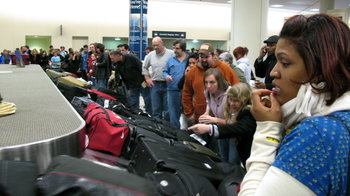Accurately perceive situations in fast moving environments such as noticing that someone is suddenly working directly behind you with a power tool. | Ascend / descend a ladder. |
Communicate with customers over the phone and in person. | Constantly move around a large facility to gather items from shelves. |
Detect heat, fire and smoke to identity safety issues on site. | Judge the flavor of food. |
Keyboard dozens of pages of text each hour. | Lift 100 pounds. |
Move a cart that weighs up to 200 pounds around a warehouse up to 10 miles a day. | Operate a computer / peripheral device / machine. |
Pick up items at speed from a conveyor belt. | Quickly move a fire hose up to 250 feet across irregular urban terrain. A fire hose can weigh hundreds of pounds when full. |
Regularly access low and high spaces that may be at irregular angles such as under a desk. | Remain in a stationary position for 4-6 hours at a time. |
Repeatedly lift 20-80 pounds. | Steadily hold medical devices for several minutes at a time. |
Use tools weighing 1-10 pounds for hours at a time. | Use tools with great accuracy. |
Visual acuity of at least 20/40 in either or both eyes with or without corrective lenses. | Visually confirm readings on small dials in the cockpit. |
Wear appropriate protective gear such as a helmet, goggles, mask and protective footwear as applicable. | Work aboard a small ship in a variety of ocean conditions. |
Work at significant heights. | Work in bad / extreme weather. |
Work in cold environments. | Work in hot / humid environments. |
Work in loud / chaotic environments. |
Inclusive & Accurate
Physical requirements avoid making unnecessary assumptions with words such as move as opposed to walk. However, physical requirements must plainly state when some specific physical capacity is required. For example, some tasks will require visual information to complete a task safely. This can be stated as "visually confirm." However, if a job requires an actual visual acuity score this can be stated directly.| Overview: Physical Requirements | ||
Type | ||
Definition | Specifications of the physical demands of a job, activity or task. | |
Best Practice #1 | Avoid making assumptions about specific abilities -- stick to the physical demands of the task. | |
Best Practice #2 | Use plain language, be direct, be honest -- avoid using cryptic language such as uncommon ways to say things. | |
Related Concepts | ||




























